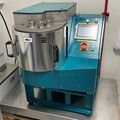Slurry mixing involves combining active materials, conductive additives, binders, and solvents to create a homogeneous electrode slurry mixture. This slurry is then coated onto a current collector to form the electrode. Proper slurry mixing ensures optimal performance, consistency, and longevity of the batteries.
Components of the Slurry
- Active Material: The main component responsible for electrochemical reactions. Examples include lithium cobalt oxide (LCO) for cathodes and graphite for anodes.
- Conductive Additives: Materials like carbon black or carbon nanotubes that enhance electrical conductivity.
- Binders: Polymers such as polyvinylidene fluoride (PVDF) that provide mechanical stability and adhesion to the current collector.
- Solvents: Liquids such as N-Methyl-2-pyrrolidone (NMP) or water used to dissolve binders and facilitate mixing.
Mixing Process
Preparation
- Weighing: Accurately measure all components based on the desired electrode composition.
- Pre-mixing: Pre-mix dry powders (active material and conductive additives) to ensure uniform distribution.
Dispersion
- Add Solvent: Gradually add the solvent to the pre-mixed dry powders while stirring at a low speed to avoid agglomeration.
- High-speed Mixing: Use high-shear mixers or ball mills to break down agglomerates and ensure even distribution of particles. This step typically lasts several hours.
Binder Addition
- Slow Addition: Add the binder slowly to the slurry while mixing to prevent clumping.
- High-shear Mixing: Continue high-shear mixing until the binder is fully dissolved and evenly distributed.
Homogenization
- Vacuum Deaeration: Remove air bubbles from the slurry using a vacuum to prevent defects in the coated electrodes.
- Final Mixing: Conduct a final mixing phase at moderate speed to ensure a homogeneous mixture.
Equipment
Mixers
- Planetary Mixers: Ideal for small-scale or laboratory use, providing thorough mixing with minimal shear.
- High-shear Mixers: Suitable for large-scale production, offering efficient particle dispersion and homogenization.
- Ball Mills: Used for breaking down agglomerates and achieving fine particle distribution.
Dispersers
- Ultrasonic Dispersers: Utilize ultrasonic waves to break up particle agglomerates.
- Bead Mills: Employ grinding beads to achieve fine dispersion of particles.
Process Parameters
Temperature
- Maintain a controlled temperature (typically 25-40°C) to ensure binder solubility and prevent solvent evaporation.
Mixing Speed
- Optimize mixing speed based on the slurry viscosity and desired particle size distribution. High speeds enhance dispersion but may cause excessive heating.
Mixing Time
- Ensure adequate mixing time to achieve homogeneity without over-mixing, which can cause degradation of materials.
Quality Control
Viscosity Measurement
- Regularly measure slurry viscosity using viscometers to ensure consistency. Target viscosity varies depending on the electrode type but is generally within the range of 500-5000 cP.
Particle Size Analysis
- Perform particle size analysis using laser diffraction or dynamic light scattering to ensure uniform particle distribution.
Homogeneity Testing
- Test slurry samples for homogeneity using techniques such as scanning electron microscopy (SEM) or energy-dispersive X-ray spectroscopy (EDS).
Safety Considerations
- Personal Protective Equipment (PPE): Wear appropriate PPE, including gloves, goggles, and respirators, to protect against hazardous chemicals.
- Ventilation: Ensure proper ventilation in the mixing area to prevent solvent vapor accumulation.
- Spill Containment: Implement spill containment measures to handle accidental spills safely.
Troubleshooting
Agglomeration
- Cause: Insufficient mixing or inadequate dispersing agent.
- Solution: Increase mixing time or speed, or add more dispersing agent.
Viscosity Fluctuations
- Cause: Inconsistent binder or solvent addition.
- Solution: Ensure precise and controlled addition of components.
Poor Adhesion
- Cause: Incomplete binder dissolution or inadequate mixing.
- Solution: Extend mixing time and ensure thorough binder integration.
Proper slurry mixing is essential for high-performance battery electrodes. By following these guidelines and continuously monitoring process parameters, manufacturers can achieve consistent and reliable slurry formulations.
jsondata
| uuid | "a6c6b673-d314-531e-83bc-e1010db7a848" |
|---|
| label | |
|---|
| description | | text | "mixing of slurry constituent components together with a solvent to create an electrode slurry" |
|---|
| lang | "en" |
|---|
|
|
|---|
| type | | "Category:OSWae9cf54c182245149a65b0149eaa7c0c" |
|
|---|
| subclass_of | | "Category:OSWdc0857e150454dd3a1e45ce54e9b2903" |
|
|---|
| kit_step_id | "03" |
|---|
| kit_id | "03-Mixing" |
|---|
| successors | | "Category:OSWee19075c31b35c3eaf0b83cac19bc282" |
|
|---|
| outputs | | "Category:OSW399f6c882f20561d87d228df95979148" |
|
|---|
| parameters | | "Category:OSW80630facef2154d0b471c4c4f1b7ea5f" |
| "Category:OSW8773127d2a9e536693b465ca785beb0e" |
| "Category:OSWf8fd20bf3266517e98c878e7e50fa331" |
| "Category:OSW59cb6fc2bc575f45acfafc8c8b747d81" |
| "Category:OSW6f2fb01a719e54b88e90314e486ea07d" |
| "Category:OSW237c5139fc6e5f4693e0ca915e5d7832" |
| "Category:OSW570dcd237ca755bc84e08aea8af94f1a" |
| "Category:OSW0e56da6612725ec6856afdefbdc95ed5" |
| "Category:OSW195b325b87045702aab822b86fc71d03" |
| "Category:OSW40377b5dc2d75b77a2fd51b1abc570da" |
| "Category:OSWf794c9fe87435ba191e8f9a8a1e8fc6f" |
|
|---|
| depends_on | | "Category:OSW2f21c5451bb551318c5e90e7789c3532" |
| "Category:OSW84a0a96459b356f8b4eb9152e4896395" |
| "Category:OSWc77a69b0fe0b57ac9615010e80b3e0b1" |
| "Category:OSWa526e2b88e565286a8e901492717d654" |
| "Category:OSW2bd2c95471055cf0979a9c20272626e9" |
| "Category:OSWfd8baecf474f5eccb6a7919bf3fe4f44" |
| "Category:OSW587daee861725bd983fdd8e2edf4369c" |
| "Category:OSW28aa797fd2fd52748ecc5d14a89ffe8d" |
| "Category:OSW16f7d5641dce50689e24186e8fe7c230" |
| "Category:OSW596061a8481e5f889e4578e72a515d2b" |
| "Category:OSW9930e02f2ff15a9f85d184a9b0998ae1" |
|
|---|
jsonschema
| @context | | "/wiki/Category:OSWdc0857e150454dd3a1e45ce54e9b2903?action=raw&slot=jsonschema" |
|
|---|
| allOf | | $ref | "/wiki/Category:OSWdc0857e150454dd3a1e45ce54e9b2903?action=raw&slot=jsonschema" |
|---|
|
|
|---|
| type | "object" |
|---|
| uuid | "a6c6b673-d314-531e-83bc-e1010db7a848" |
|---|
| title | "" |
|---|
| title* | |
|---|
| description | "mixing of slurry constituent components together with a solvent to create an electrode slurry" |
|---|
| description* | | en | "mixing of slurry constituent components together with a solvent to create an electrode slurry" |
|---|
|
|---|
| required | |
|---|
| properties | | type | | default | | "Category:OSWa6c6b673d314531e83bce1010db7a848" |
|
|---|
|
|---|
|
|---|
This category currently contains no pages or media.
